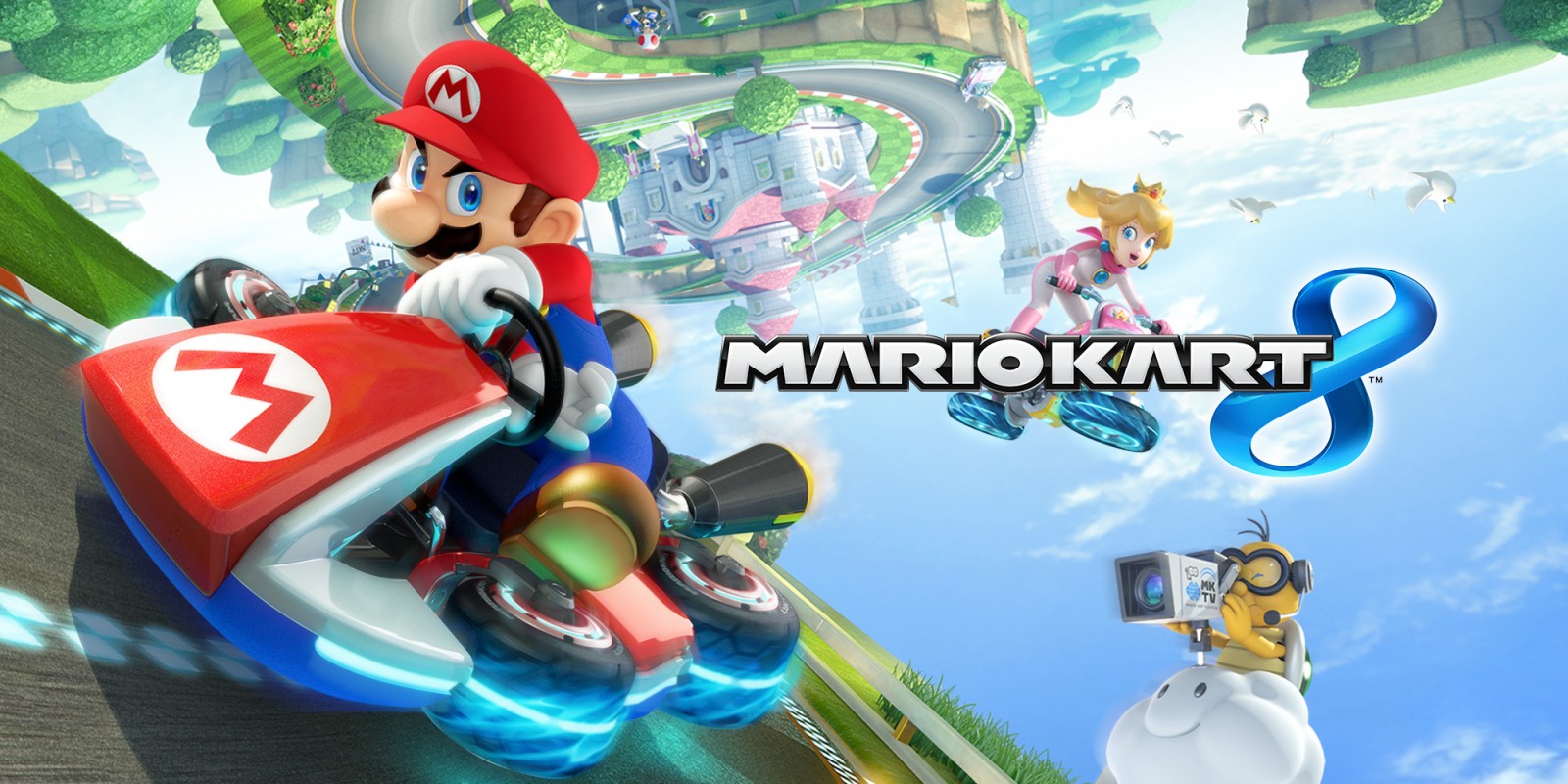This review was originally written on June 3rd, 2014.
Mario Kart 8 is the newest installment in the long-running Mario Kart series. While the older games relied solely on kart racing, Mario Kart 8 adds zero-gravity portions to the race tracks in conjunction with the underwater and airborne segments introduced in Mario Kart 7.
Mario Kart 8 also allows customization of the player’s vehicle to alter speed, acceleration, handling, and traction during the race. Some of the changes are purely aesthetic as multiple pieces share the same stats, but this gives the player a wider selection of choices to differentiate him or herself from other racers. The number of options is rather limited at the beginning, but the more the player progresses through the game, the more choices open up to the player.
Where the newest Mario Kart shines the most, however, is in its gameplay. The core mechanics remain the same—race through a course with three laps while skillfully utilizing items to surpass other players in hopes of achieving first place. Drifting returns with a slightly different feel from past games, but any seasoned Mario Kart veteran will adapt to the changes within a few races. Coins appear in this installment yet again, allowing players to hold up to a maximum of 10, offering a speed boost based on the current quantity held. Underwater, airborne, and zero-gravity segments all transition seamlessly into the levels without hampering the player’s performance the rest of the race. Zero-gravity does pose some perplexing questions, however, such as why players receive a boost when they collide with each other or run into shining blue objects in these areas. The later difficulties do pose a fair challenge, but fortunately are not required to unlock all the characters. Seasoned Mario Kart veterans may even find a challenge here, annoyed as the AI uses advanced techniques to catch up and solely focuses items on the player.
Multiplayer, as with any game in the Mario Kart series, is the quintessential element of Mario Kart 8, and it delivers. For the first time ever, the Grand Prix mode allows four players to play simultaneously. Only the top-scoring player’s results matter, allowing the other players to enjoy the game as well without worry of score. The game also permits a variety of different controller types, ranging from the Wii U gamepad, the Wii U Pro controller, the Wii Classic Controller, the Wiimote + Nunchuck combo, to the Wiimote + Wheel combo. Strangely, the map of the stage is only visible on the Wii U gamepad, offering the player that uses it a slight advantage. The Battle Mode is unfortunately a slight disappointment, no longer placing players on a set field but on the race courses where the battle elements feel more like a race than a fight.
Item distribution feels slightly more fair than past games, but unfortunately still isn’t perfect, often hitting the player in first with a blue shell seconds before the finish line and keeping players in the back of the pack together with unnecessary red shells. Two of the biggest changes to the item feature are the addition of the horn block, which repels any incoming item when used, including blue shells, as well as the loss of the ability to hold on to an item while storing another. While neither of these changes is particularly positive or negative, they do bring a different approach to item use. Wasting a horn block on a red shell when a blue shell is right behind could cost the player the match; dropping a banana before picking up another item block may yield a coin and leave the player defenseless.
One of the most debated aspects of Mario Kart 8 comes with its unique character roster. Offering a total of 30 different playable characters, it is the largest cast ever seen in the series. Unfortunately, seven of the slots are taken by the Koopalings, classic characters from the Mario series who recently made a comeback with New Super Mario Bros. Wii. The game also has a total of five baby characters, which are merely baby versions of their adult counterparts. Metal Mario and the newly introduced Pink Gold Peach also have joined the race, which are completely single-colored variants of their respective characters. Due to this, some of the more original characters from past titles are absent, leaving out fan favorites such as Dry Bones and Diddy Kong.
The online component of Mario Kart 8 may very well be one of Nintendo’s finest offerings. Replays of games may be shared, tournaments can be held where players can race together and compete for points, and friends may leisurely stroll through stages at will. The matchmaking feature works well, placing players together from around the world with little to no input delay and nigh-invisible lag during races. Unfortunately, voice chat is restricted to lobby communication and is restricted during races. Additionally, during my time with the game, I found myself disconnected from lobbies after only a few races. While not a major issue as this never occurred during races, it is a small annoyance that would necessitate rejoining lobbies.
Ultimately, Mario Kart 8 is a fantastic racing title that delivers on what it promises—racing. Even with difficult AI, an awkward roster choice, and a few missteps with the online mode, the game manages to perform outstandingly. Playing the game with friends is an amazing experience, bringing everyone together. Zero-gravity is a fun addition alongside the underwater and airborne elements. Mario Kart 8 is a wonderful installment in the Mario Kart series and can be enjoyed by just about anyone.
Final Score: 8/10
